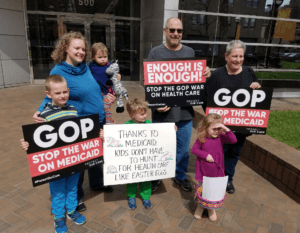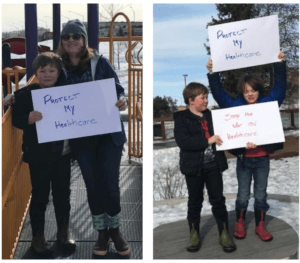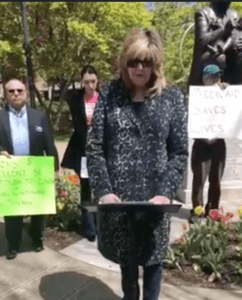Throughout the first week of Medicaid Awareness Month, advocates stood up for the millions of kids and families who live healthy, happy lives thanks to this essential program — and spoke out against Republican proposals to weaken and cut Medicaid.
 Medicaid advocates rally Friday in Charleston, West Virginia
Medicaid advocates rally Friday in Charleston, West Virginia
Protect Our Care released state-by-state Medicaid fact sheets as a resource for advocates.
 Alaskans rally for kids’ healthcare on Tuesday at Cuddy Family Park in Anchorage.
Alaskans rally for kids’ healthcare on Tuesday at Cuddy Family Park in Anchorage.
The Center on Budget and Policy Priorities released a brief on How Medicaid Work Requirements Will Harm Children as well as a blog: Medicaid Continues to Help Schools Help Children.

In Knoxville, advocates from the Tennessee Health Care Campaign, ForwardTN, Protect My Care, and Planned Parenthood shared stories about why Medicaid matters for Tennessee families and kids.
Tracy Nájera, the Executive Director for the Children’s Defense Fund-Ohio, highlighted how the program helps Ohio kids to succeed. Read her post:
Medicaid Protects America’s Children
Community Catalyst Blog
For more than a year, Congress has lobbied a variety of attacks at Medicaid. The challenge to defend the program has forced advocates to become very clear about why and how Medicaid is such a valuable program for children and families. And after a year of intensified study, the evidence is clear: Medicaid is saving the day for children and families all over this country.
Medicaid is protecting our babies.
Close to 45 percent of all U.S. births are covered by Medicaid: 52 percent in my home state of Ohio and as many as 72 percent of all births in New Mexico. Medicaid coverage is literally saving these infant’s lives. As the American Journal of Public Health’s study found, states that expanded Medicaid saw greater declines in their infant mortality rates between 2010 and 2016 than those that did not expand. The decline more than doubled for Black infant mortality rates compared to non-expansion states. Medicaid’s reach extends beyond infant care in our urban cores; Medicaid covers about 51 percent of rural births nationwide. Savvy states are leveraging Medicaid to address poor outcomes for infants in the wake of the opioid crisis by tackling Neonatal Abstinence Syndrome. As of February of this year, West Virginia became the first state to receive approval from the U.S. Centers for Medicare and Medicaid Services (CMS) to offer Neonatal Abstinence Syndrome (NAS) treatment services.
Medicaid is protecting our nation’s students, providing affordable and comprehensive health coverage for nearly 30 million children. Much of this care takes place directly inside of schools through school- based health services for low-income children. Services provided include preventive services and treatment as well as age-appropriate screening for vision, dental, and blood lead levels—a critical screening in places like Flint, Michigan and other high risk communities. And according to a recent survey of nearly 1,000 school and district leaders from around the country, 68 percent use Medicaid reimbursements to pay for school-based health professionals like nurses, counselors and psychologists for mental and behavior health, physical and occupational therapy, and speech pathology. Medicaid has been keeping our nation’s special education afloat for years by supplementing insufficient funding provided through the Individuals with Disabilities Education Act (IDEA).
Medicaid is a smart tool for tackling racial disparities and geographic inequity in our rural and Appalachian regions.
Between 2013 and 2016, the child uninsured rate fell from 7 percent to 4 percent, representing 2 million more insured children nationwide. At the same time, we experienced significant declines in racial disparities in children’s uninsured rates with the most significant movement towards gap-closing occurring between White and Hispanic children, where it declined from 7 percent to 4. The impact of Medicaid expansion on coverage in rural areas is also notable. Medicaid now covers 45 percent of rural children nationwide, and the rural child uninsured rate has dropped from 9 percent to just 6 percent. That means all the difference for a child whose family has delayed dental care for a cavity for few months to save up for the procedure or for a child in desperate need of speech therapy to be understood by her teacher and classmates.
Through this all, the Children’s Defense Fund-Ohio continues to push for progress on Medicaid enrollment and access to care for children and families by partnering with Ohio’s Medicaid department to close the remaining uninsured child gap and capitalize on opportunities to enroll children—especially immigrant children. We are growing access to physical, mental, and behavioral care by working to expand our state rules on telehealth and assisting schools in providing access to Medicaid-covered health services beyond the Medicaid in Schools Program. At the same time, we are working to protect Ohio’s children and families as Ohio adds itself to the list of states seeking an 1115 demonstration waiver from CMS place work requirements for Ohio’s Medicaid Expansion enrollees. We are raising the flag for children and families, defending against these measures which will push thousands of families out of needed health coverage in this critical time of economic recovery in Ohio. And as many other advocates in Ohio and around the country, we remain vigilant and alert to defend against any new federal Medicaid challenges.
Advocates can be proud to continue to protect Medicaid as we enter this year’s Medicaid Awareness Month. Medicaid is a game changer for children bringing tangible value in prevention and intangible value in the lives it is changing and saving. The need is growing and we must be relentless in our struggle to ensure all eligible children receive the care they need.

